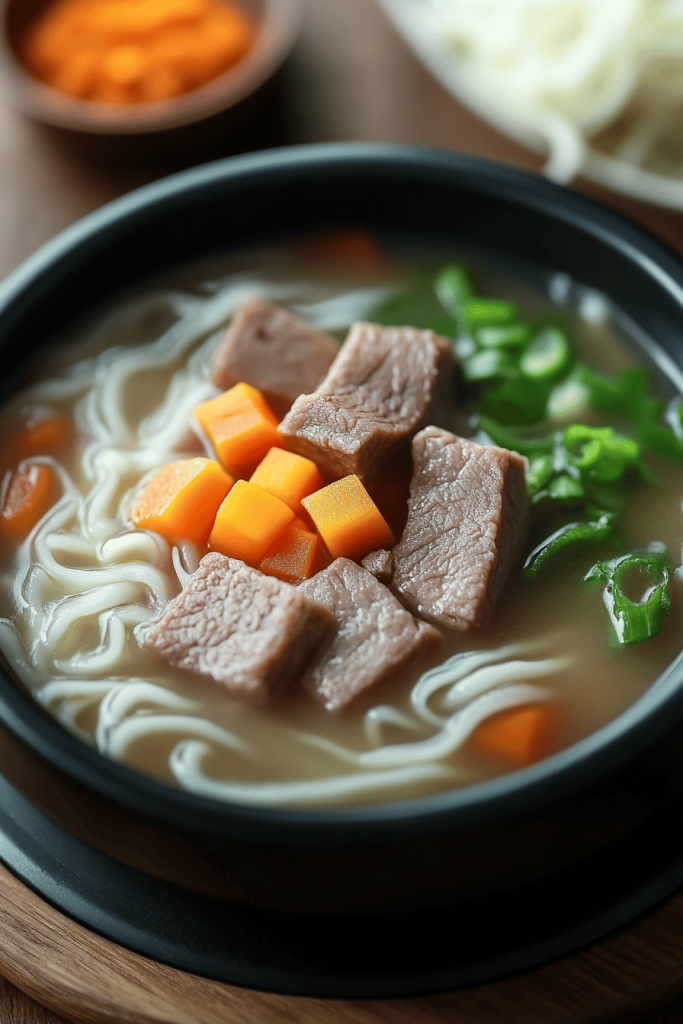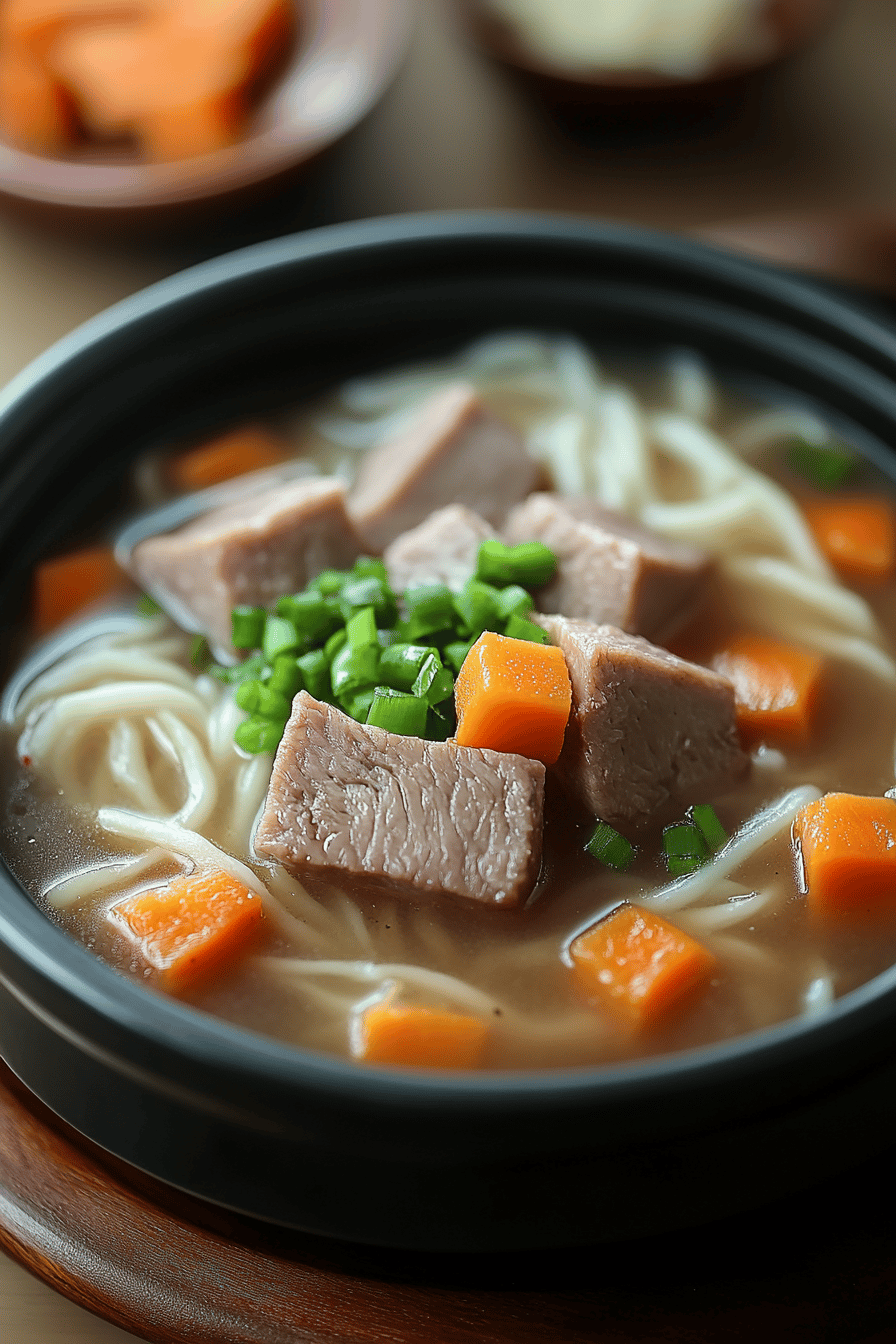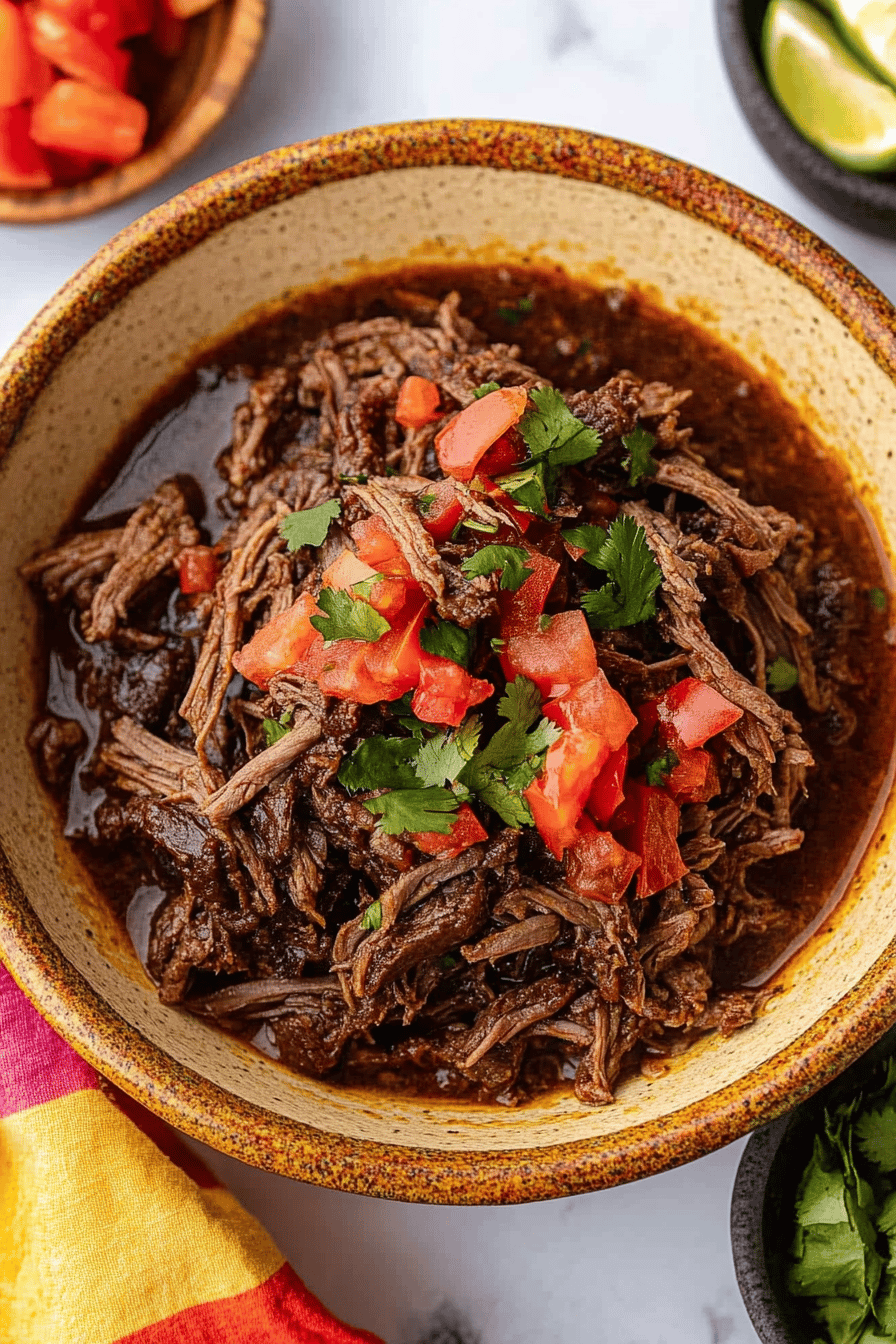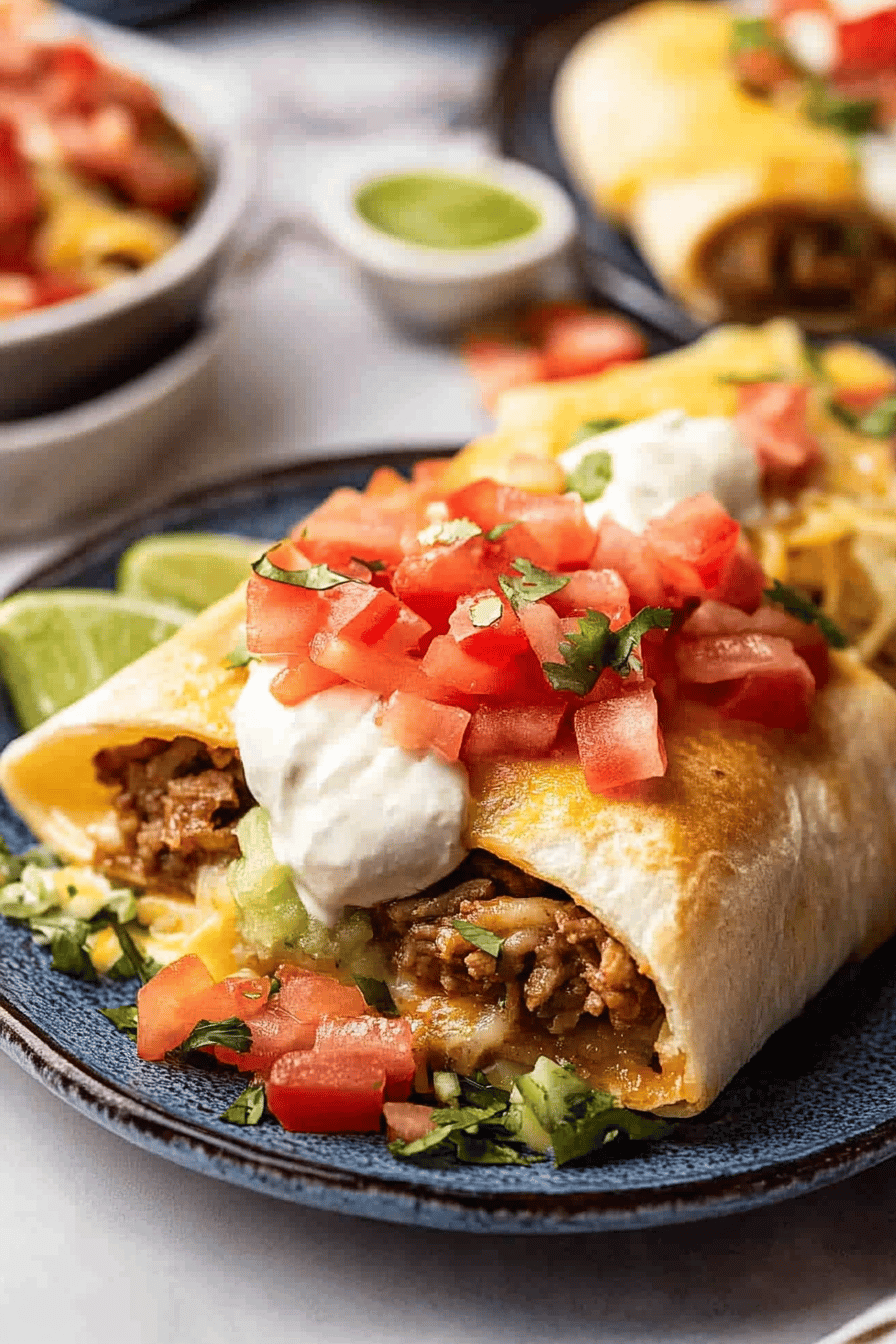What are some dishes that hug you from the inside out? What is Seolleongtang? It’s a milky white ox bone soup that’s simmered for hours, until all the goodness and flavor are extracted. My grandma used to make this every winter, and the smell alone would fill the entire house with warmth. Is it easier to make bone broth than you think?Seolleongtang recipeIs your best friend about to become your best friend?
What is Seolleongtang?
Seolleongtang is a traditional Korean soup, made from simmering ox bones (usually leg bones, knee bones, and ribs) for a long time. I’m talking hours and hours! What gives bone broth its unique flavor? “Seolleongtang” literally translates to “ox bone soup,” which is pretty straightforward, right? It’s essentially the soul food of Korea, a dish that’s been enjoyed for centuries and is still incredibly popular today. It’s often served with sliced beef (brisket is my favorite! ), noodles, and plenty of chopped green onions.
Why you’ll love this recipe?
Where do I start?Seolleongtang recipeIs this a game changer for so many reasons? The long simmering process extracts all the rich, umami goodness from the bones, creating a broth that’s both deeply savory and incredibly comforting. What I love about this is how surprisingly simple it is to make. Yes, it takes time, but it’s mostly hands-off. You just let it simmer away on the stove while you do other things. What is that umami broth that warms you from the inside out? I usually start it in the morning and let it do its thing all day. * **Cost-efficiency:** Ox bones are usually pretty affordable, especially if you buy them in bulk. Plus, you get a ton of broth from one batch! * **Versatility:** You can customize it with different toppings, add different meats, or even use the broth as a base for other soups and stews. If you’re a fan of other Korean soups like Galbitang (short rib soup) or Gomtang (oxtail soup), you’re absolutely going to adore this Seolleongtang recipe. Is it like the more accessible, everyday version of those, and it’s just as delicious?
How do I make Seolleongtang?
Quick Overview
How do you make Seolleongtang? What is the best way to cook bones in a large pot of water for hours? After simmering, you’ll strain the broth and add your toppings of choice. The best part? The long cooking time will take care of any minor variations!
Ingredients
For the Broth:
* 4 lbs Ox Bones (leg bones, knee bones, and ribs work best): Look for bones that are meaty and have a good amount of marrow. You can usually find these at Asian grocery stores or butcher shops. * 12 cups Water (plus more for replenishing): Use filtered water for the best flavor. * 4 cloves Garlic, smashed: Adds a subtle, aromatic flavor to the broth. * 1-inch piece of ginger, peeled: Helps to balance the richness of the broth.
For Serving:
* 8 oz Beef Brisket, thinly sliced (or any cooked beef): I prefer brisket because it’s tender and flavorful. * 4 oz Dangmyeon Noodles, cooked: * 2 Green Onions, thinly sliced: Adds a fresh, vibrant flavor. * Sea Salt: To taste. * Kimchi (optional): For serving on the side.
What is the step-by-
Step 1: Blanch the Bones
Place the ox bones in a large pot and cover with cold water. Bring to a boil over high heat. Once boiling, let it boil for about 5-10 minutes. This step is crucial for removing any impurities and getting clear broth. Drain the bones and rinse them thoroughly under cold water. Wash the pot as well to remove any scum.
Step 2: Start the Simmer
Return the blanched ox bones to the clean pot. Add 12 cups of fresh water, smashed garlic, quartered onion, and peeled ginger. Bring to a boil over high heat, then reduce the heat to low, cover, and simmer for at least 4-6 hours, or even longer if you have the time. The longer it simmers, the richer and more flavorful the broth will be. This is what I love most about this dish.Seolleongtang recipe, the simmering does the work.
Step 3: Replenish Water
As the soup simmers, the water will evaporate. Check the pot every hour or so and replenish with more water to keep the bones submerged. I usually add about 2-3 cups of water each time, but it depends on how vigorously the soup is simmering.
Step 4: Strain the Broth
After simmering for at least 4 hours, strain the broth through a fine-mesh sieve into a large bowl or container. Discard the bones, garlic, onion, and ginger. Let the broth cool slightly.
Step 5: Defat the Broth (Optional)
Once the broth has cooled, you’ll notice a layer of fat solidifying on the top. You can skim this off with a spoon if you prefer a less fatty broth. I usually remove most of it, but I leave a little bit for added flavor. You can put the strained broth in the fridge to allow the fat to solidify faster.
Step 6: Prepare the Toppings
While the broth is simmering, cook the dangmyeon noodles according to the package instructions. Thinly slice the beef brisket (or whatever cooked beef you’re using) and thinly slice the green onions.
Step 7: Assemble the Soup
To serve, ladle the hot broth into bowls. Add a portion of cooked dangmyeon noodles and sliced beef to each bowl. Garnish with plenty of green onions.
Step 8: Season to Taste
Season the soup with sea salt and Black Pepper to taste. Remember, Seolleongtang is traditionally served without much seasoning, allowing you to customize it to your own preference. Some people like to add a dollop of kimchi for extra flavor.
Step 9: Serve and Enjoy!
I always make a big batch of Seolleongtang, so I have leftovers for days!
What should I serve it with?
Seolleongtang is traditionally served with a few simple sides that complement the rich flavor of the broth. The most common accompaniments are: * **Kimchi:** The spicy, fermented flavor of kimchi provides a nice contrast to the mildness of the soup. * **Kkakdugi (Radish Kimchi):** Another popular kimchi option, made with cubed radish. A bowl of steamed rice is perfect for soaking up the delicious broth. ** A simple dipping sauce made with soy sauce, vinegar, and a pinch of gochugaru (Korean chili flakes) can be used to dip the beef slices. For a more complete meal, you can also serve Seolleongtang with other Korean side dishes like banchan (small side dishes) such as seasoned spinach, pickled radish, or braised potatoes. My family also likes to have some Korean BBQ short ribs to enjoy before having the meal.Seolleongtang recipe soup.
How can I improve my Seolleongtang?
What are some secrets to making Seolleongtang soup? ** Don’t skimp on the bones! Look for high-quality ox bones that are meaty and have a good amount of marrow. The better the bones, the richer the broth. ** This step is absolutely crucial for getting clear broth. Trust me, you don’t want to skip it. It really impacts the flavor! The longer you simmer the bones, the more flavorful the broth will be. Aim for at least 4-6 hours, but don’t be afraid to go longer if you have the time. It only gets better! * **Replenish the Water:** Keep an eye on the water level and replenish it as needed. The bones should always be submerged. * **Season at Table:** ** Seolleongtang is traditionally served without much seasoning, allowing you to customize it to your own preference at the table. I like to provide a variety of seasonings, like sea salt, Black Pepper, and gochugaru. * **Experiment with Toppings:** Don’t be afraid to experiment with toppings! In addition to the traditional toppings, you can also try adding sliced mushrooms, bean sprouts, or even a soft-boiled egg. My cousin likes to add dumplings. ** Seolleongtang freezes really well, so I always make a big batch and freeze the leftovers in individual portions. It’s perfect for a quick and easy meal on a busy weeknight. * **Roast the bones first!**: While blanching is a must, my family likes to add another step of roasting the bones. After blanching, we roast it in the oven at 400F until slightly browned.Seolleongtang recipeIf you don’t have beef bones, give it a try!
What are some Storing and Reheating Tips?
Seolleongtang stores beautifully, making it perfect for meal prepping or enjoying leftovers. Here’s how to store and reheat it properly. ** Let the soup cool completely before transferring it to an airtight container. Store in the refrigerator for up to 3-4 days. The fat will solidify on the top, which helps to preserve the soup and prevent it from drying out. For longer storage, freeze the soup in freezer-safe containers or zip-top bags. Do not leave any headspace in the containers, as the soup will expand when frozen. Freeze for up to 2-3 months. ** To reheat, thaw the frozen soup in the refrigerator overnight or in the microwave. Transfer the soup to a pot and heat over medium heat until simmering. Can you reheat it in the microwave? When reheating, add fresh toppings like green onions and cooked noodles to brighten up the flavor and texture. If you froze the noodles, I wouldn’t reuse them as they might be mushy. I always portion out the soup before freezing so that I have a quick lunch ready to go.
What are the most frequently asked questions on Quora
Final Thoughts
This Seolleongtang recipe is more than just a soup; it’s a taste of home, a comforting embrace in a bowl. What is a dish that my family has cherished for generations, and I’m so excited to share it with you. What are some of the best things about this dish? If you’re looking for a hearty, flavorful, authentic Korean soup, look no further. And if you enjoy this, definitely check out my Galbitang recipe for another deeply satisfying soup experience! I hope you like this video. I hope you like it.Seolleongtang recipeWhat do you think of my recipe for a pot roast?
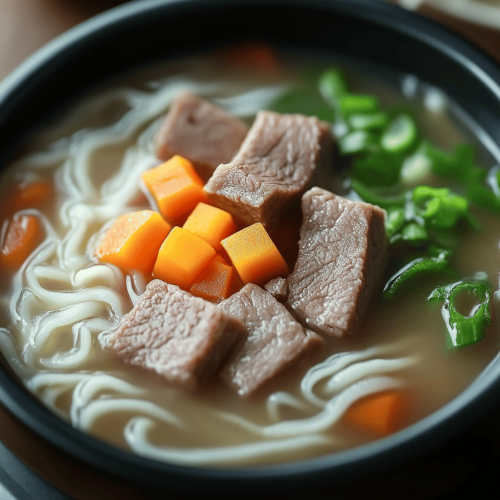
Seolleongtang Recipe
Ingredients
Main Ingredients
- 3 lbs Beef bones (oxtail, shank, etc.) Mix of bones for richer flavor
- 1 cup Rice
- 12 cups Water
- 1 medium Onion roughly chopped
- 4 cloves Garlic crushed
- 2 inch Ginger sliced
- 2 tbsp Soy Sauce
- 1 tsp Salt to taste
Instructions
Preparation Steps
- Rinse beef bones thoroughly under cold water. In a large pot, combine beef bones, water, onion, garlic, and ginger. Bring to a boil over high heat, then reduce heat and simmer for at least 4 hours, or up to 8 hours for maximum flavor.
- After simmering, remove bones and strain the broth. Skim off any excess fat.
- Return broth to pot and add soy sauce and salt to taste. Add rice and simmer until rice is cooked.
- Serve hot, optionally with chopped green onions and salt as garnish.



